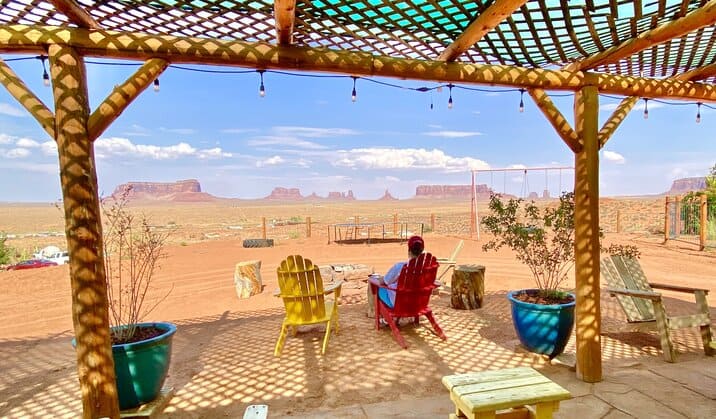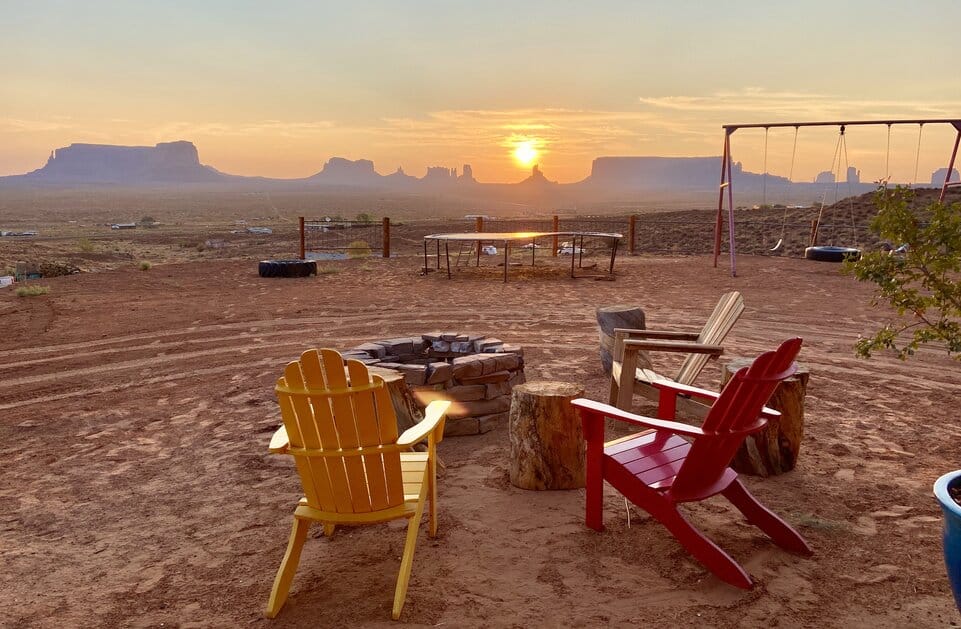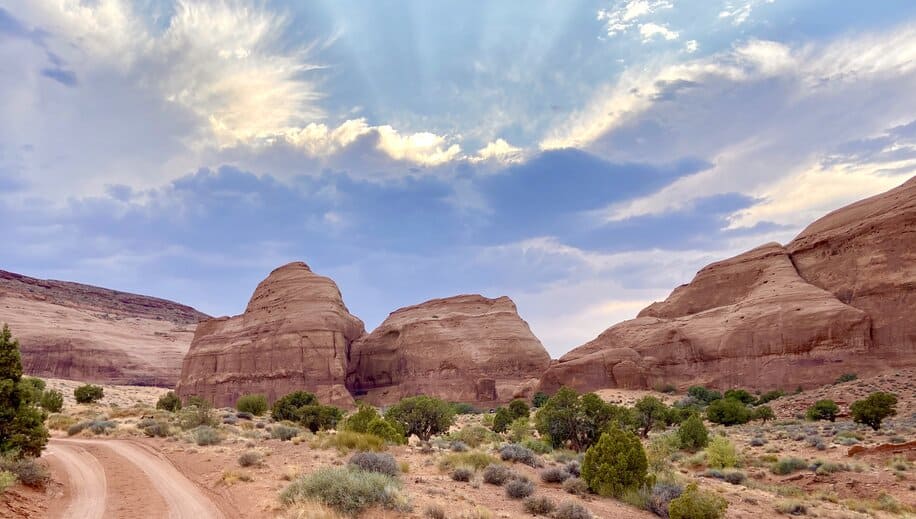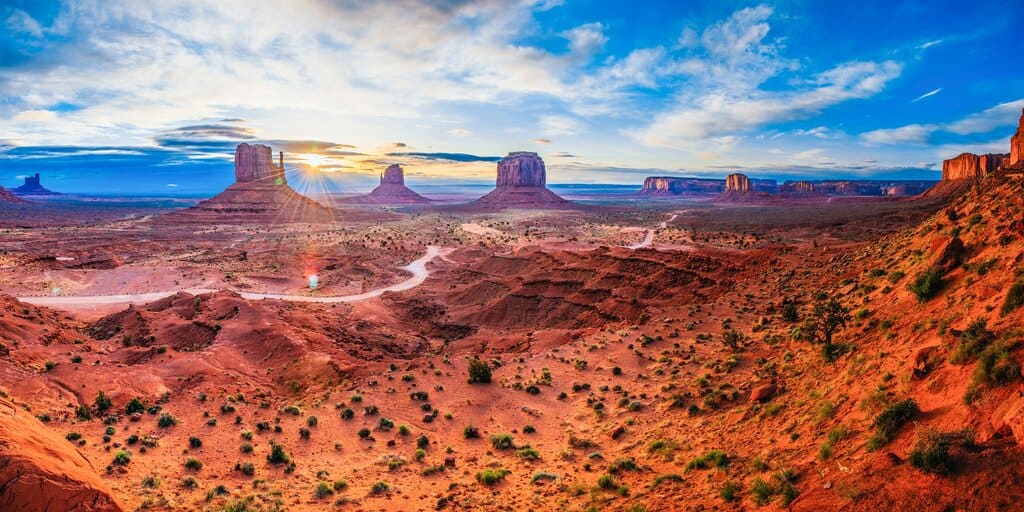Are you headed to Monument Valley and looking for a good guide to the region? Look no further. You’ve made it to the right place!
You’ve probably seen Monument Valley before, even if you’re not quite sure what it is. There’s a famous scene in Forrest Gump where Tom Hanks is running up a hill in the desert, beard gone mad, dozens of people following him, and he just stops. He turns to his followers and says that after three years of running he’s pretty tired and it’s time to go home.
In the background, massive sandstone buttes rise from the red desert floor. A lonely road divides them in the distance. This is Monument Valley at the border of Utah and Arizona, and it’s one of the most fascinating landscapes on earth.
That hill that Forrest stopped at is now a popular tourist stop on the road through Monument Valley, which can be roughly defined as the area of red sandstone rock formations in southern Utah and northern Arizona.
The region lies entirely within Navajo Nation (more on that later) and is a playground for desert nature lovers. Read on to learn all about how to visit this stunning area of the southwestern United States.
Read on to learn all about how to visit Monument Valley, Utah, an incredibly stunning area of the southwestern United States.
Note: this article contains affiliate links, which means that should you purchase something or get a quote through them I may make a small commission at no additional cost to you. This helps keep the site running with up to date information. I do not represent Booking.com, GetYourGuide, or Discovercars.com. This is information only and not a recommendation to buy the product mentioned in this article..
Monument Valley, Utah – What You Need to Know
Where is Monument Valley?
Monument Valley, Utah Along Highway 163 between Mexican Hat, UT and Kayenta, AZ. The nearest city of any sizeable population is Flagstaff, AZ about three hours south. It’s essentially the middle of nowhere. It’s about a six hour drive from Las Vegas through some of the most fascinating scenery the United States has to offer.
What is Monument Valley?
Monument Valley is a loose term used to describe the region of sandstone rock formations along the AZ/UT border. There is no official boundary to the region. There is also a town named Oljato-Monument Valley that straddles the border and a protected area of Navajo Nation named Monument Valley Navajo Tribal Park. When someone says “Monument Valley” they are most likely referring to the general area.

How do I get to Monument Valley?
This is rural America, so you’ll need a car unless you’re visiting on an organized tour. It’s also not really close to any major city so a weekend trip is out of the question unless you live in Phoenix or Albuquerque (maybe Las Vegas or Salt Lake City).
The closest airport you can realistically get a commercial flight to is in Page, AZ. But you’ll likely hit Monument Valley as a part of a longer road trip across southern Utah.
No matter where you start from you will need to rent a car. For renting cars in the US we usually use Discovercars.com, as they typically have the best rates and get a lot of the smaller rental agencies on their site. You can use the link below to find a great deal on a rental car.
Click here to book a great deal on a rental car in the US!
Food in the area
There are not a lot of options for places to eat in the region unless you go down to Kayenta, the only formidable town nearby. There you can find all your typical American fast food.
But why do that? In the town of Monument Valley there is one proper restaurant at Goulding’s Lodge, the Stagecoach Restaurant. They also have a pretty decent grocery store if you’re cooking yourself.
There is also a restaurant at the tribal park as well as a few dining options in Mexican Hat. For the local specialty, try a Navajo taco. It’s unlike anything you’d expect from a taco.
What’s the weather like?
It’s the desert so it’s hot and dry. But thanks to its relatively high elevation (5000 – 6000 feet), it doesn’t get as quite hot as say Phoenix, Las Vegas or recreation areas like Saguaro National Park. But it can still get damn hot, so plan any hikes in the morning.
The area is also known for summer thunderstorms. We were treated to a night time lightning show on our first night there.

Electricity
This might sound surprising but a sizable portion – about 30% – of Navajo Nation is off the electrical grid. Many houses will have their own solar power and some just don’t have electricity. Our guest house had solar power, but it couldn’t last all night. There was a backup generator for when the solar ran out, but often we just slept without the electricity on.
When should I visit Monument Valley?
Monument Valley is a year-round destination. The buttes can look quite cool with snow on them in the winter. It doesn’t get deathly hot in the summer either, as this is the high desert in Utah. Fall and spring are the best time to go to avoid crowds at the main attractions and have the best chance for perfect weather.
Where should I stay in Monument Valley?
There are not that many places to stay in the region. There is Goulding’s Lodge in the town and The View Hotel at Monument Valley Tribal Park, as well as a couple hotels nearby in Mexican Hat and Kayenta. There’s a KOA on the Utah side if you fancy some camping.
There are, however, some truly amazing places you can rent on Airbnb. We stayed at a guest houses that goes by the “Dream Catcher House” and we highly recommend it. The owner – Nate – built it by himself. It has the absolute best views of Monument Valley of anywhere you can stay and gets an amazing sunset.
The Dream Catcher House also comes equipped with an outdoor kitchen, trampoline, and fire pit. The entire property runs on solar power so the electricity is spotty, but you won’t want to do anything but sit outside and enjoy the view!

How long should I stay?
Two days is more than enough time to see Monument Valley. You can also see all the main sites in one day, but you won’t have much time to relax or get out on a walk through the desert.
Navajo Nation
Sparing you the American history lesson of how Native Americans ended up on reservations, the Navajo people own this land that is now world famous. It lies within both Utah and Arizona – and thus the United States – so it’s not technically a country.
It does have its own government and laws though. There’s nothing special you have to do but just be aware that this area is very important to the Navajo people and respect their guidelines, customs and laws.
Travel Insurance
Americans can skip this section. But if you are an international visitor you will need travel insurance for your trip to the States and it must cover medical expenses. We don’t have universal healthcare here in the US of A and an overnight hospital stay can easily cost your entire savings or more.
Insubuy provides medical travel insurance for international visitors to the US. You can book your insurance using this link.
Lay of the Land
In this post I’m considering Monument Valley to be the general area of large sandstone buttes in southern Utah and Northern Arizona. This can area can be broken down into the following sub-areas:
- Goosenecks State Park and Mexican Hat
- Valley of the Gods
The majority of this lies in Utah, with only a small portion in Arizona that accounts for the majority of the tribal park. I’ll skip Kayenta and its immediate surroundings because it is not as impressive as the areas I’ll discuss here.
There are also some neat rock formations along the roads passing through Navajo Nation in Arizona. There are tons of places to stop for awesome views, but I’ll stick to the tribal park in my discussion here.

US Highway 163 is the only road through the region. Coming from the south you’ll first hit Oljato-Monument Valley town and the tribal park, followed by Goosenecks and Mexican Hat and finally Valley of the Gods before you ascend a hill into a completely different terrain heading north towards Moab, UT.
Coming from the north you’ll hit the sights the opposite way. Some would argue coming from the north is more beautiful because you get the most famous Monument Valley view as you’re driving in.
Oljato-Monument Valley and the Tribal Park
There is a lot to see in the immediate region of the UT/AZ border. The town of Ojlato-Monument Valley is actually split between the states. The most famous views of Monument Valley you’ve seen in movies or on Instagram are from around here. So let’s walk through the things to see and places to go.
Oljato-Monument Valley Town
“Town” is a loose word here. It’s not really a town but more of a village of houses with a grocery store and one hotel. This is where we stayed at the guest house I mentioned previously. There are great views of some of the best sandstone buttes from the town.

From behind Red Door Mesa, you can do a nice hike through a canyon where you will be surrounded by red rocks towering over you. You probably won’t see any other people on this trail as it’s not well known. I couldn’t even find it online, so below I’ve taken a screenshot of the trail and highlighted it. You can access it from behind the Airbnb I mentioned earlier or from Rock Door Canyon Road.

Monument Valley Navajo Tribal Park
Monument Valley Navajo Tribal Park is the crown jewel of the region. Most of the large mesas are found within its borders. For an entry fee of $20 per vehicle, you can take the scenic drive through the red rocks.
There are many gorgeous viewpoints to stop at and some short walking trails you can do. Some of the views you might recognize from old western movies with John Wayne or from National Lampoon’s Vacation.

If you’re up for a hike, the most popular trail – the Wildcat Trail – starts right by the visitors center. It’s mostly flat and looks pretty similar to the hike around Uluru in central Australia.
Forrest Gump Point
Arguably the most famous Monument Valley view in Utah, thanks to the best movie ever (Forrest Gump), this spot is up a serious hill looking down onto some of the buttes within the tribal park. From here, the buttes are about 7 miles away, which gives you a perspective of just how big these sandstone rock formations are.

Forrest Gump point is a pretty popular spot for people to stop at, so depending on how busy it is you might have to wait to get your photo running up the highway like Forest did in the movie.
You’ll also have to wait for a time clear of cars. Luckily, the road is straight for about 4 miles so you will see cars coming towards you well in advance. Behind you the visibility isn’t as good, but you’ll have plenty of time to move if you hear a car coming.
There are also many other viewpoints along Highway 163. You really can’t go wrong. Some of them will have Navajo artists selling their art or jewelry. Don’t go beyond any fences though, as most of the land is privately owned.
Ancient Ancestral Puebloan Cave Dwellings
A few miles off the main highway there are the ruins of some ancient Native American cave dwellings. The Anasazi people in this region used to live in cave cities, much like many cultures 1200 years ago. If you’re not going to make it to Mesa Verde National Park in Colorado to see the ancient cave cities, which is not too far from here, these could be worth a visit.
Monument Valley Tours
If all this is a bit overwhelming and you’d rather have a local show you around, then an organized tour might be for you. You can off-road on a jeep, ride a horse, or just a guided tour of the tribal park. You can check out some tours in Monument Valley in the banner below. I have not personally used any tour in this region so I can’t recommend any of them, but most of them look like a good time.
Goosenecks State Park
The little known stepchild of Canyonlands National Park, Goosenecks ($5 per vehicle) is an impressive Utah state park with a wild river that cuts through a canyon. The San Juan River “goosenecks” through the canyon, creating awesome views as it twists and turns around sharp bends.

Goosenecks is an easy 30 minute stop when driving along Highway 163, just outside of Mexican Hat. There really isn’t much to do in the park – unless you’re hiking into the canyon – other than take in the views. There is a small parking area with some picnic tables right at the edge of the canyon.
We went for sunset and packed a simple dinner and some beers, staying about 90 minutes total. That included having dinner and scrambling on the rocks down a bit into the canyon before sunset.
There is a primitive camping site – i.e. just a patch of dirt – that you can camp overnight at if you wish. It’s also a popular spot for campervans to park overnight. If you want to hike into the canyon there is only one trail, the Honaker Trail, and it’s a bit of a ways from the parking lot.
You have to walk along the canyon rim for a bit to get there before descending steeply into the canyon down to the river. Check out the trail on AllTrails for more information.
Valley of the Gods
Another hidden gem is the often overlooked Valley of the Gods. This is essentially a scenic drive around more sandstone monoliths. The unique thing about it is that it’s not crowded at all and you really feel like you have the entire desert to yourself. The scenic drive is about 16 miles and the entire time we were there we saw one other car.

The start of the drive is right off of Highway 163. It’s easy to miss, as it’s just a small dirt road and there isn’t any signage other than a simple “Valley of the Gods” sign about 200 feet before the turn. The entire drive is on a dirt road but it’s in good condition and is no problem with a standard 2WD car.
The road spits you out on a side road – route 261 – north of Goosenecks State Park. From there it’s about 7 miles back to the highway. Or if you want an aerial view of the valley head north on route 261 and you’ll climb right up the red rocks to look down on the Valley of the Gods.
A bit Further from Monument Valley
The desert southwest in Utah and Arizona is – at least in my opinion – the most beautiful place in the United States and one of the most beautiful places on earth. There is no shortage of incredible places to visit in this region.
Monument Valley should be just one stop on a road trip through this barren land of red rocks and endless canyons. For more places to check out, below you’ll find a list of some awesome places all within a 4 hour drive of Oljato-Moument Valley.
- Antelope Canyon (AZ)
- Horseshoe Bend (AZ)
- Grand Canyon North Rim (AZ)
- Vermilion Cliffs (AZ) (good luck getting a permit for The Wave, instead consider Valley of Fire right outside of Las Vegas)
- Petrified Forest National Park (AZ)
- Lake Powell (UT)
- Grand Staircase-Escalante National Monument (UT)
- Glen Canyon National Recreation Area (UT/AZ)
- Arches National Park (UT)
- Canyonlands National Park (UT)
- Dead Horse State Park (UT)
- Zion National Park (UT)
- Capitol Reef National Park (UT)
- Bryce Canyon National Park (UT) (OK it’s more like 5 hours but this place is so amazing you must go)
- Four Corners Monument (UT/AZ/NM/CO)
- Mesa Verde National Park (CO)
- San Juan National Forest (CO) (check out my post on the Ice Lake Trail)
- Telluride (CO)
- Durango (CO)
There are many more I can list. But this should get you started. You could spend an entire year travelling around the area in a four hour radius of Monument Valley and still not see all the sights. It’s truly spectacular.
Monument Valley, Utah – FAQs
Can you just drive through Monument Valley?
You can drive through Monument Valley. In fact, it’s mostly a driving destination, with limited hikes. Whether you are inside Monument Valley Tribal Park or outside the park boundaries, driving is the best way to see the spectacular landscape.
What is so special about Monument Valley?
Monument Valley is special because it features unique sandstone rock formations unlike anything you can see anywhere else in the world. The region is a relatively flat high desert with giant buttes that arise from the desert floor, seemingly out of nowhere in random locations.
Is Monument Valley worth going to?
Monument Valley is absolutely worth visiting. It’s one of the most unique landscapes on the planet and it’s not too difficult to get to. There are scenic drives, a few hikes, and other activities to keep you entertained while you’re there.
What movies have been filmed in Monument Valley?
Way too many to list. However, some of the most famous are:
-Forrest Gump
-Stagecoach
-Billy the Kid
-The Searchers
-The Lone Ranger
-National Lampoon’s Vacation
The list goes on and on!
Can you see Monument Valley for free?
You can see Monument Valley for free, but not Monument Valley Tribal Park. The park – owned by Navajo Nation – contains the most stunning rock formations in the region. But there are plenty of amazing things to see and do outside the park as well, and those are free.
Final Word
Monument Valley and its immediate surroundings present a unique landscape found nowhere else on earth. There are so many amazing places to stop and see that you’ll want to keep coming back. If you’re lucky you might even witness a desert thunderstorm. Have you been to Monument Valley and think I missed something important in this post? Let me know in the comments below!


1 comment
[…] the border of Utah and Arizona lies one of the most fascinating landscapes on the planet. Monument Valley is a barren desert floor with massive sandstone rock buttes protruding from it in irregular […]